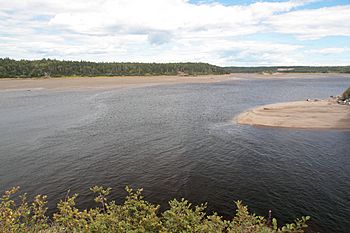Sheldrake River (Minganie) facts for kids
Quick facts for kids Sheldrake River |
|
|---|---|

The river near its mouth, from Quebec Route 138
|
|
| Native name | Manto Sipo |
| Other name(s) | Rivière Sheldrake |
| Country | Canada |
| Province | Quebec |
| Region | Côte-Nord |
| RCM | Minganie |
| Physical characteristics | |
| River mouth | Gulf of Saint Lawrence 0 metres (0 ft) 50°16′18″N 64°55′45″W / 50.271667°N 64.929167°W |
| Length | 106 kilometres (66 mi) |
| Basin features | |
| Basin size | 1,183 square kilometres (457 sq mi) |
The Sheldrake River (also known as Rivière Sheldrake in French) is a river in the Côte-Nord region of Quebec, Canada. It flows for about 106 kilometers (66 miles). This river empties into the Gulf of Saint Lawrence, which is a large arm of the Atlantic Ocean.
A power station on the river helps make electricity for people. This station can produce 25 megawatts of power.
Contents
Where is the Sheldrake River?
The Sheldrake River starts in a mountainous area. The highest peaks in this area are almost 850 meters (2,790 feet) tall. It begins between two lakes, Lake Manitou and Lake Magpie.
The river flows south in a winding path. Along its way, you can find many waterfalls and fast-moving sections called rapids. Another river, the East Sheldrake River, joins it about 30 kilometers (19 miles) before it reaches the sea.
The Sheldrake River flows into the Saint Lawrence River. This happens near the village of Sheldrake. It is located about halfway between the cities of Sept-Îles and Havre-Saint-Pierre. It can be tricky for boats to enter the river from the sea. This is because of shifting sand and a bridge near its mouth.
In 1851, a man named P.J. Touzel from Jersey was the first European to settle here. He started a big fishing business. A lake on the river, Lake Touzel, is named after him.
What's in a Name?
The Indigenous people, the Innu, have their own name for the river. They call it Manto Sipo, which means "Manitou River." Manitou is a spirit or life force in their beliefs.
Interestingly, the Manitou River, which is about 25 kilometers (16 miles) to the west, is called Manto Sipis by the Innu. This means "Little Manitou River."
The Sheldrake River has had a few names over time. On an old map from 1829, it was called "Sheldrake R." Another map from 1833 called it "Sawbill." Both "sheldrake" and "sawbill" are types of water birds. These birds are part of the duck family. The Innu also call the nearby Tonnerre River Ursuk Sipo, which means "Sawbill River."
Power from the River
A special project was planned to build a power station on the Sheldrake River. This station uses the river's water to create electricity. It is located at a spot called "Courbe du Sault."
The power station can produce up to 25 megawatts of electricity. Building it started in March 2010. The station was ready to make power by early December 2012. This project helps provide clean energy to the area.
The River's Home (Basin)
Every river has a "basin." This is the entire area of land where all the rain and snow eventually drain into that river. The Sheldrake River basin covers a large area of 1,183 square kilometers (457 square miles).
The Sheldrake River basin is located between two other river basins. To the west is the Chaloupe River basin. To the east is the Tonnerre River basin. The land in this basin is mostly covered by spruce trees and moss.
Helping the Salmon Return
In 2015, an exciting project began to help salmon return to the Sheldrake River. For many years, fishing for salmon was not allowed because there were very few left.
Scientists and local groups worked together to bring the salmon back. Here's how they did it:
- They planned to catch young salmon, called smolts, from a nearby river.
- These smolts would be taken to special fish stations. There, they would grow into adult salmon.
- Once adults, their eggs (roe) would be collected. These eggs would be placed in special incubators. These incubators were set up right at the Sheldrake River's power station.
- When the baby salmon (fry) hatched, they would be released into the Sheldrake River.
In July 2015, over 89,000 young salmon were released into the river. They were placed upstream from a large waterfall that salmon could not pass. This project is part of a bigger plan to help Atlantic Salmon in the Côte-Nord region. Many groups, including Hydro-Québec and Université Laval, are working together to make sure the salmon thrive.


